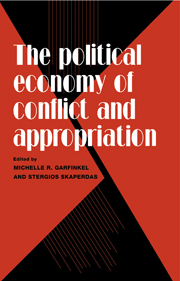Book contents
- Frontmatter
- Contents
- List of contributors
- Acknowledgments
- 1 Introduction: Conflict and appropriation as economic activities
- 2 Anarchy and its breakdown
- 3 Towards a model of territorial expansion and the limits of empire
- 4 Predation and production
- 5 Competitive trade with conflict
- 6 Increasing returns to politics in developing countries with endogenous protection in a fixed-factor model
- 7 Demosclerosis, or special interests “R” us: An information rationale for political gridlock
- 8 Deforestation, investment, and political stability
- 9 Violence and the assignment of property rights on two Brazilian frontiers
- Index
2 - Anarchy and its breakdown
Published online by Cambridge University Press: 30 December 2009
- Frontmatter
- Contents
- List of contributors
- Acknowledgments
- 1 Introduction: Conflict and appropriation as economic activities
- 2 Anarchy and its breakdown
- 3 Towards a model of territorial expansion and the limits of empire
- 4 Predation and production
- 5 Competitive trade with conflict
- 6 Increasing returns to politics in developing countries with endogenous protection in a fixed-factor model
- 7 Demosclerosis, or special interests “R” us: An information rationale for political gridlock
- 8 Deforestation, investment, and political stability
- 9 Violence and the assignment of property rights on two Brazilian frontiers
- Index
Summary
What do the following have in common?
International struggles for control of the globe's resources.
Gang warfare in prohibition era Chicago.
Miners versus claim jumpers in the California gold rush.
Animal territoriality.
Male elephant seals who fight to sequester “harems” of females.
Answer: These are all anarchic situations.
Anarchy is not chaos. At least potentially, anarchic relationships can constitute a stable system. But not all environments are capable of sustaining an anarchic order. Anarchy can break down, to be replaced by another pattern of relationships.
Anarchy is a natural economy (Ghiselin, 1978), or spontaneous order in the sense of Hayek (1979). Various forms of spontaneous order emerge from resource competition among animals, including territoriality and dominance relationships. As for humans, while associations ranging from primitive tribes to modern nation-states are all governed internally by some form of law, their external relations one with another remain mainly anarchic. Yet intertribal or international systems also have their regularities and systematic analyzable patterns.
The term “anarchy ” in ordinary usage conflates two rather different situations that the biological literature carefully distinguishes: “scramble” versus “interference” competition (Nicholson, 1954) - or, in an alternative terminology, “exploitation” versus “resource defense” (Krebs and Davies, 1987, p. 93). Under scramble competition, which might be termed amorphy (absence of form), resources are not sequestered but consumed on the move. In the open sea, for example, resources are so fugitive that fish do not attempt to defend territories.
- Type
- Chapter
- Information
- The Political Economy of Conflict and Appropriation , pp. 15 - 40Publisher: Cambridge University PressPrint publication year: 1996
- 3
- Cited by



